Finally, the missing piece in your pain journey.
From the physical therapist who pioneered the Hip Hook™, The Mark® uniquely targets the root cause of lower back & hip pain: deep iliacus & psoas muscle tension others miss. Experience powerful release in just 90 seconds.
You've tried everything. It's not your fault.
When muscles feel “tight,” most people start with stretching. When that doesn't bring pain relief, they escalate—massage guns, appointments, injections, medications, and more.
But here's what most miss: muscle tension isn't always about flexibility. Sometimes your brain keeps a muscle contracted when it should be at rest—creating hidden strain on your joints, bones, and nerves that blocks true relief.
Office Visits
You kept searching for someone who "gets it."
It's challenging to find skilled providers, leaving you with run-of-the-mill treatments that don't work.
Medications
They offered short-term relief—but not real resolution.
Pills mask pain, they don't solve what's causing it. Without addressing the source of irritation, inflammation returns… and so do the medications.
Surgery
An invasive solution that may not even be the real source of your pain.
Surgery permanently alters your structure—even when muscle tension may have been the real issue all along. Many go under the knife and still feel the same pain. Or far worse.
Other Tools
You've tried foam rollers, massage guns, and every mobility gadget out there.
However, most tools apply pressure broadly—not precisely—and rarely reach the deep muscles that are actually causing the problem. They may feel good in the moment, but the tension always comes back.
You've done everything. But nothing addressed tension in your iliacus muscle.
Show Me The Solution
Meet the Mark®
The Original Hip Hook™. This is the missing piece. Designed to reach the iliacus—the hidden muscle behind so much pain—and help it release in just 90 seconds. Because real resolution starts where others never look.
Clinical Results, At Home
Engineered by a physical therapist to replace her expertly skilled hands, reaching deep tension—like the iliacus—that other tools miss.
90-Second Relief
Hold. Breathe. Release. Reset your body in under two minutes with a simple, science-backed habit that relieves tension and restores alignment
Immediate Relief
Most users feel a noticeable difference after their very first session.* Make it part of your routine to unlock deeper, longer-lasting results.
Expert Guidance
Includes step-by-step guidance crafted by licensed physical therapists, so you're never guessing.
Validated by Clinicians.
Experienced by Real Users.
External studies and self-reported outcomes show that the Mark reduces pain, eases tension, improves sleep, and provides long-lasting results.
Experienced immediate relief from lower back pain after a single use (p<0.05)
Significant decreases in muscle tension in the hip flexors after just one use (p<0.01)
Reported better sleep quality on the PSQI due to reduced nighttime low back pain episodes
All participants maintained their improvements after the trial—and no side effects were reported
* These results may not apply to your condition. Please consult your physician prior to use and consult our safety instructions for further information.
Your Body's Reset
Starts Here
Not all muscles are created equal. These six muscles are foundational to how your body moves and feels. When you release them, everything else starts working better—naturally.
Click on any highlighted point on the body diagram to learn about these key muscles and how they affect your overall well-being.

How the Mark Works
Designed by a Physical Therapist. Built for your hands.
Three simple steps. One precise tool.
Position
Place the Mark in your hip flexor area. The anatomical design and expert guidance make placement easy every time.
Apply Pressure
Lean into the Mark for 90 seconds of sustained pressure. Relax and let your body weight do the work as the iliacus and psoas muscles release.
Feel the Release
Experience immediate relief as decades of tension dissolve. Your hip flexor tension and pain will begin to subside within moments.
Mark® vs. Everything Else
You've likely tried these other solutions. Here's how they compare—on cost, convenience, and results that actually last.
Swipe left to see all columns →
Introducing The Set
A complete system designed by a physical therapist to release the muscles that matter most.
The Set includes the Mark for iliacus and psoas release, the Orbit for glutes and piriformis, the Range for spine and neck tension, and the Band for functional movement retraining. You'll also receive the bestselling book Tight Hip, Twisted Core—to understand the “why” behind your pain and how to fix it.
Together, it's everything you need to release tension, realign your body, and feel like yourself again.
Complete toolkit for whole-body pain relief and alignment
60-day money-back guarantee
Clinical Grade Design
600,000+ Users
90 Second Relief
Meet Christine Koth, MPT
Meet Christine Koth, MPT
"I discovered the iliacus connection after years of watching patients struggle with treatments that only addressed symptoms. The moment I understood how this hidden muscle affects the entire body, everything changed."
25+ years treating chronic pain patients who tried everything
Master in Physical Therapy and BS in Biochemistry with Honors from University of Wisconsin - Madison
Best-Selling Author on the iliacus and muscle tension
“The Mark isn't just another tool—it's the result of understanding pain at its true source. I created it to replicate my fingers because everyone deserves access to real relief, not just those who can afford to go come and see me.”
Frequently Asked Questions
Get answers to the most common questions about the Mark device and iliacus muscle release.
Pain doesn't have to be your normal.
Join thousands using the Mark® to release tension, restore movement, and finally feel aligned again.
Try it risk-free for 60 days. Your body will know.

Real Stories from
Real People
Thousands of people have found relief with Aletha. Here are just a few of their stories.
Rob M.
Before the Mark:
After the Mark:
Natalie C.
David K.
Tony W.
John B.
Michelle H.
Gary P.